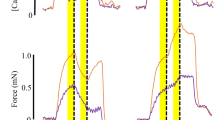Summary
Isometric tension of skinned fibres from the frog semitendinosus muscle is sigmoidally related to Ca2+ concentration betweenpCa 7 and 6. Stiffness measurements showed that the Ca2+-activated tension may be due to recruitment of attached cross-bridges. In the absence of ATP (rigor solution) the skinned fibre develops a rigor tension which reaches about 80–110% of the maximum Ca2+-activated tension.
However, stiffness measurements showed that in rigor many more cross-bridges are attached to actin at any one moment than in contraction. It was concluded that the force per cross-bridge is 37% smaller in rigor than in contraction.
Similar content being viewed by others
References
Beinbrech, G., Kuhn, H. J., Herzig, J. W., Rüegg, J. C.: Evidence for two attached myosin cross-bridge states of different potential energy. Cytobiologie12, 385 (1976)
Dickhaus, H., Herzig, J. W., Kuhn, H. J., Rüegg, J. C.: Elasticity of muscles in contraction and rigor. Experientia30, 678 (1974)
Heinl, P., Kuhn, H. J., Rüegg, J. C.: Tension responses to quick length changes of glycerinated skeletal muscle fibres from the frog and tortoise. J. Physiol. (Lond.)237, 243 (1974)
Hellam, D. C., Podolsky, R. J.: Force measurements in skinned muscle fibres. J. Physiol. (Lond.)200, 807 (1969)
Herzig, J. W.: Mode of stretch activation in heart muscle. Pflügers Arch.355, R 13 (1975)
Herzig, J. W.: Mechanical evidence for a conformational change of attached cross-bridges during muscle contraction. Pflügers Arch. Eur. J. Physiol.362, R 25 (1976)
Huxley, A. F., Simmons, R. M.: Proposed mechanism of force generation in striated muscle. Nature233, 533 (1971)
Huxley, A. F., Simmons, R. M.: Mechanical transients and the origin of muscular force. Cold Spring Harb. Symp. quant. Biol.37, 669 (1973)
Podolsky, R. J., Nolan, A. C.: Muscle contraction transients, cross-bridge kinetics, and the Fenn effect. Cold Spring Harb. Symp. quant. Biol.37, 661 (1973)
Podolsky, R. J., Teichholz, L. E.: The relation between calcium and contraction kinetics in skinned muscle fibres. J. Physiol. (Lond.)211, 19 (1970)
Rüegg, J. C., Kuhn, H. J., Herzig, J. W., Dickhaus, H.: Effect of Ca-ions on force generation and elastic properties of briefly glycerinated muscle fibres. In: Calcium transport in contraction and secretion, p. 547 (E. Carafoli et al., ed.). Amsterdam: North-Holland Publ. Comp. 1975
Author information
Authors and Affiliations
Rights and permissions
About this article
Cite this article
Yamamoto, T., Herzig, J.W. Series elastic properties of skinned muscle fibres in contraction and rigor. Pflugers Arch. 373, 21–24 (1978). https://doi.org/10.1007/BF00581144
Received:
Issue Date:
DOI: https://doi.org/10.1007/BF00581144




